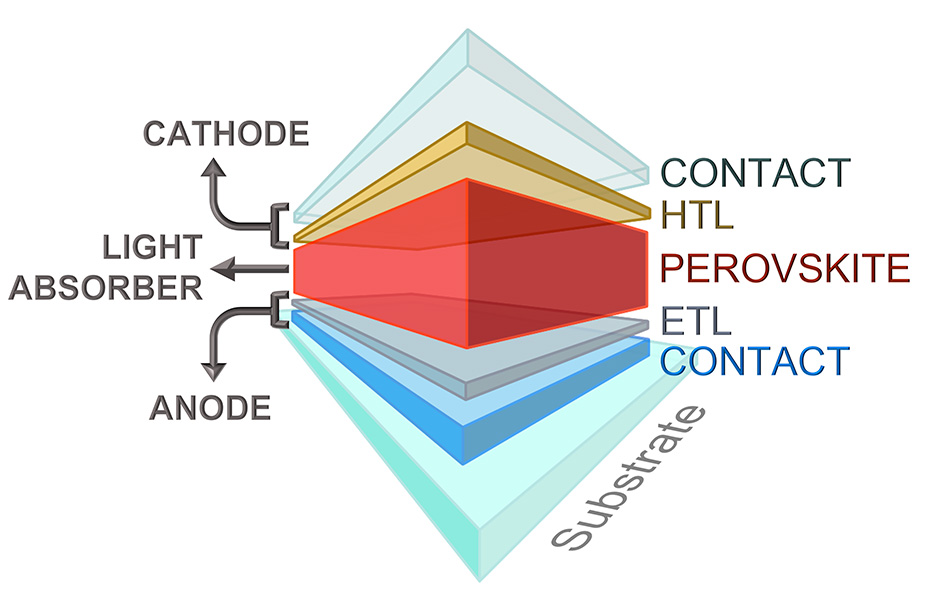A perovskite solar cell (PSC) is a type of 3rd generation solar cell that includes a perovskite-structured compound as the light-absorbing layer, which can be either a hybrid organic-inorganic or fully inorganic halide-based material. Perovskite-type absorbers exhibit excellent opto-electronic properties and are very high defect tolerant structure, particularly those with 3D structures such as methylammonium iodide (MAPbI2). Because of their high tolerance, the absorbers can be designed with tuneable bandgaps through the control of halide content in the structure without major changes. This facilitates greatly the fabrication of multijunction structures using layers with very similar structures that combinedly can absorb throughout a wide spectrum window, allowing the Shockley-Queisser power conversion efficiency (PCE) limit for a single-junction cell to be surpassed.
Since their discovery in 2009, developments in cell architecture design and deposition techniques have rocketed their PCE from 3.8% to 27.7% in single junction devices, exceeding the PCE of the best single-crystal silicon PV cells. A maximum PCE of 29.8 % was recently achieved in perovskite-silicon multijunction device, and all-perovskite multijunction cells offer the possibility to obtain architectures with PCE values up to 31.9% (comparable to multijunction III-V cells) at a very low carbon footprint.
What are the main advantages of perovskites solar cells?
Perovskite absorbers are direct band gap semiconductors and have long diffusion lengths for charge carriers, so they are strong light absorbers and can therefore achieve high-efficiency whilst being very thin. This circumstance grants PSCs desirable properties such as high flexibility, semi-transparency, and a lightweight. They are also cheap and quick to produce as they can be manufactured through solution-based methods. PSCs can also be recycled up to a 99.2%, allowing reuse of materials that can reduce fabrication costs.
What is holding back solar cells?
Even though perovskite-based PV technology is the fastest-growing technology, several challenges prevent it from massive commercialization. Firstly, current fabrication methods cannot adapt to production line manufacturing, which difficult scaling up of cell dimensions; Secondly, PSCs suffer from ambient instability due to their hygroscopic nature and degradation upon prolonged exposure to UV light and heating; Lastly, the best performing devices are fabricated using Pb, which degrades to water-soluble compounds that both hinders device stability and are environmentally hazardous. In addition, PSCs exhibit a current-voltage hysteresis that affects their performance, whose causes are still unknown.
What is next?
Scientist worldwide are developing a wide range of solutions to the challenges involved in PSC fabrication and commercialization ranging from device structure engineering, surface texturing, encapsulation with hydrophobic and UV-blocking polymers to substituting Pb by other transition metals. Concurrently, novel validation methods and testing protocols are being developed to further advance this relatively new technological filed.
Such approaches have already yielded improvements such as significant increases in cell size structures of PSCs with favourable bandgaps and ambient stability, and further advances are expected in the immediate future. All in all, this photovoltaic technology has showcased a very fast-advancing development in the last decade, recently taking its first commercialization steps.
References:
- A. K. Jena, A. Kulkarni and T. Miyasaka, Chem. Rev., 2019, 119, 3036–3103.
- J. Gong, S. B. Darling and F. You, Energy Environ. Sci., 2015, 8, 1953–1968.
- H. J. Snaith, Nature Mater, 2018, 17, 372–376.




